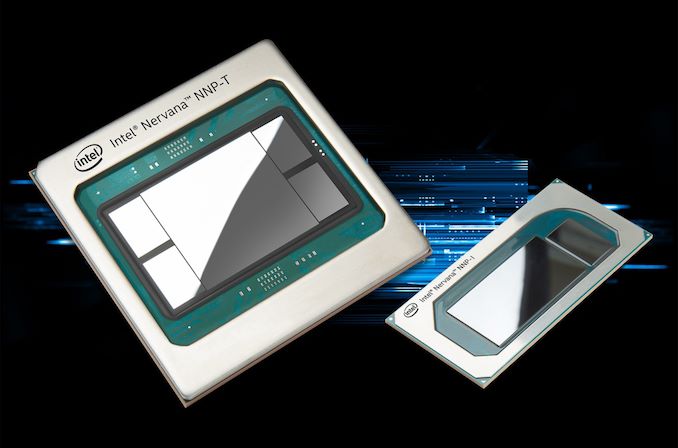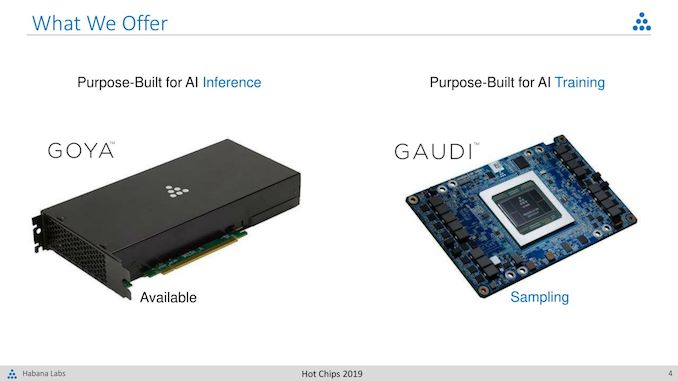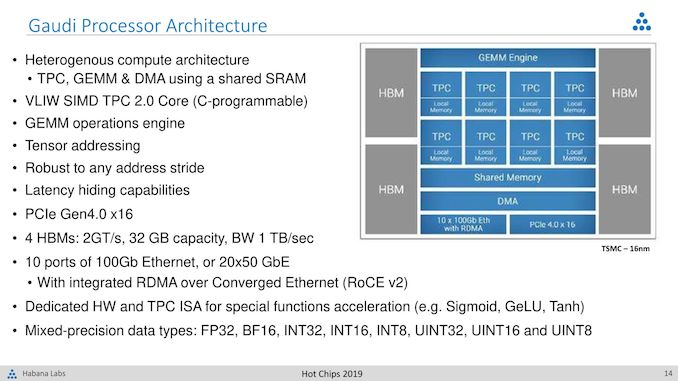Intel Whittles Down AI Portfolio, Folds Nervana in Favor of Habana
by Ryan Smith on February 3, 2020 10:00 PM EST
Over the past several years, Intel has built up a significant portfolio of AI acceleration technologies. This includes everything from in-house developments like Intel’s DL Boost instructions and upcoming GPUs, to third party acquisitions like Nervana, Movidius, and most recently, Habana labs. With so many different efforts going on it could be argued that Intel was a little too fractured, and it would seem that the company has come to the same conclusion. Revealed quietly on Friday, Intel will be wrapping up its efforts with Nervana’s accelerator technology in order to focus on Habana Labs’ tech.
Originally acquired by Intel in 2016, Nervana was in the process of developing a pair of accelerators for Intel. These included the “Spring Hill” NNP-I inference accelerator, and the “Spring Crest” NNP-T training accelerator. Aimed at different markets, the NNP-I was Intel’s first in-house dedicated inference accelerator, using a mix of Intel Sunny Cove CPU cores and Nervana compute engines. Meanwhile NNP-T would be the bigger beast, a 24 tensor processor chip with over 27 billion transistors.
But, as first broken by Karl Freund of Moore Insights, Spring won’t be arriving after all. As of last Friday, Intel has decided to wrap up their development of Nervana’s processors. Development of NNP-T has been canceled entirely. Meanwhile, as NNP-I is a bit further along and already has customer commitments, that chip will be delivered and supported by Intel for their already committed customers.
In place of their Nervana efforts, Intel will be expanding their efforts on a more recent acquisition: Habana Labs. Picked up by Intel just two months ago, Habana is an independent business unit that has already been working on their own AI processors, Goya and Gaudi. Like Nervana’s designs, these are intended to be high performance processors for inference and training. And with hardware already up and running, Habana has already turned in some interesting results on the first release of the MLPerf inference benchmark.
In a statement issued to CRN, Intel told the site that "Habana product line offers the strong, strategic advantage of a unified, highly-programmable architecture for both inference and training," and that "By moving to a single hardware architecture and software stack for data center AI acceleration, our engineering teams can join forces and focus on delivering more innovation, faster to our customers."
Large companies running multiple, competitive projects to determine a winner is not unheard of, especially for early-generation products. But in Intel’s case this is complicated by the fact that they’ve owned Nervana for a lot longer than they’ve owned Habana. It’s telling, perhaps, that Nervana’s NNP-T accelerator, which had never been delivered, was increasingly looking last-generation with respect to manufacturing: the chip was to be built on TSMC’s 16nm+ process and used 2.4Gbps HBM2 memory at a time when competitors are getting ready to tap TSMC’s 7nm process as well as newer 3.2Gbps HBM2 memory.
According to CRN, analysts have been questioning the fate of Nervana for a while now, especially as the Habana acquisition created a lot of overlap. Ultimately, no matter the order in which things have occurred, Intel has made it clear that it’s going to be Habana and GPU technologies backing their high-end accelerators going forward, rather than Nervana’s tech.
As for what this means for Intel’s other AI projects, this remains to be seen. But as the only other dedicated AI silicon comes out of Intel’s edge-focused Movidius group, it goes without saying that Movidius is focused on a much different market than Habana or the GPU makers of the world that Intel is looking to compete with at the high-end. So even with multiple AI groups still in-house, Intel isn’t necessarily on a path to further consolidation.
Source: Karl Freund (Forbes)













42 Comments
View All Comments
III-V - Tuesday, February 4, 2020 - link
>Why did they buy Habana when they have already had Nervana?IP
HStewart - Tuesday, February 4, 2020 - link
To combine the best of both technology, it probably going to be a new product and eventually people will think they kill also Habana. I don't work for Intel so I am not sure - but that seams like logical thing to do.Eliadbu - Tuesday, February 4, 2020 - link
simply because Nervana wasn't making the cut, other companies and engineers probably told intel nervana offering wasn't good enough so they had 2 choices either try and improve the product which will take years or purchase something already available that is superior. second option is most reasonable because AI hardware is improving rapidly taking the bet you will outperform your rivals (Nvidia) with future product while your current offering is inferior is very risky. will they kill habana that depends on how its products will perform in the next few years but Intel won't have many more chances to buy another company because as time goes on fewer companies will keep up and it will be very hard for new players to get in the competition.HStewart - Tuesday, February 4, 2020 - link
Still they can always use the technology of both companies to come up with a new product. They did this the PLA stuff and came up with EMiB and Foroves.Yojimbo - Tuesday, February 4, 2020 - link
On the other hand, they bought both Cray's Dragonfly and QLogic and tried to combine them and ended up killing both of them.HStewart - Wednesday, February 5, 2020 - link
That is not the same, Cray did not purchase Dragonfly - Cray uses Intel cpus - which latest version upgrade to use Aurora - AMD has a similar supercomputer system in the mix - very old newshttps://www.eweek.com/servers/cray-opts-for-intel-...
Yojimbo - Wednesday, February 5, 2020 - link
Cray didn't purchase Dragonfly, Intel purchased it from Cray. Well actually they purchased Gemini and Aries. Dragonfly was just the name of the topology, I used the wrong name. But the point is that Intel purchased stuff from Cray, they purchased QLogic, and they tried to combine them, or so they claimed, and create Omnipath. Omnipath failed and they ended up killing both the Qlogic infiniband business and the Cray interconnect business.BTW, the Aurora machine is an Intel machine, not a Cray machine. Intel is the primary contractor, and they use Cray's new interconnect that Cray developed to replace the Gemini and Aries that was sold to Intel.
In any case, the example is very much appropriate to what people suggested about Intel combining technologies. In reality, though, Habana is a product that's already very far along, further than Nervana was, and it's very unlikely that anything from Nervana ends up in Habana products. Nervana was just a failed venture.
Spunjji - Wednesday, February 5, 2020 - link
It's a little naive to expect that there's any meaningful way they could "combine the best of both".At best, I expect they'll hang on to Nervana's IP to block off competitors.
Kevin G - Tuesday, February 4, 2020 - link
How much of this was the failure of Nervana and how much of it was failure of Intel to get 10 nm based Nervana chips out the door in a timely fashion? Would the Nervana chip had been cancelled if 10 nm was on track as originally forecast (ie we'd be on the eve of 7 nm right now)?While entirely de-emphasized, Intel did promote the idea of a Xeon chip with an on package Nervana accelerator at some point in the future. Considering that this idea was quietly swept under the rug months ago, safe to say that this was previously kill but signs pointed squarely to fab issues rather than design (how many years ago did Ice lake tape out?).
Spunjji - Wednesday, February 5, 2020 - link
They haven't even pushed out the TSCM 16nm+ version of Nervana's accelerator, and the effort involved in changing to an entirely different foundry's process is not insignificant, so I'd argue it's likely that Intel's fab woes are unrelated.